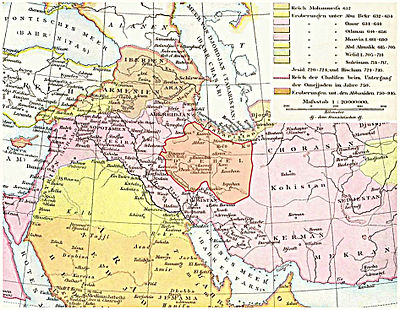Jibal

Djibal ( Arabic جبال, DMG Ǧibāl ) was the name used from the 7th to the 12th century for a major Iranian province of the caliphate empire.
Surname
The Arabic word jibāl is the plural form of jabal (mountain) and means mountains or mountains - what is meant is the Zāgros mountains . Djibal corresponds largely to the ancient region of Media , from which the Arabs derived the name māh . In the 11th and 12th centuries, especially during the Seljuk rule, the term jibal was gradually abandoned; after the Mongol conquest of Persia it was no longer used. One of the last to use it was Yaqut ; a century later used hamdallah mustawfi jibal at any point. Instead, western Persia was now referred to as Iraq adschami (Persian Iraq), which with its southern Mesopotamian counterpart, Iraq arabi (Arab Iraq), formed the two Iraqs .
Geographical (boundaries and main places)
The borders of Djibal, which also included Kurdistan and Lurestan , were not always sharply defined: In the east, the greater province with Rey as the most northeastern city bordered the Dascht-e Kavir Chorasans , in the southeast on Fars (the old Persis ), in the south on the plains from Khusistan , in the west to Mesopotamia, in the northwest to Azerbaijan (border river: Sefid Rud ) and in the north to the Elburs Mountains and the Caspian provinces ( Tabaristan , Gilan ).
The four old main towns of the province were Rey (near Tehran ), Qarmisin ( Kermanshah in Kurdistan), Hamadan and Isfahan ; The urban centers also included Dinawar (Māh al-Baṣra) and Qazvin .
history
The history of the province began when the Muslim Arabs invaded the Persian Sassanid Empire in the early 7th century as part of the Islamic expansion , to which the media had belonged until then. Despite the initial success of the Sassanids, the Arabs won the battle of Nihavand in 642. From Mesopotamia, they conquered the entire Sassanid Empire bit by bit, while the disempowered great king fled to the east. The great cities of Djibal were conquered between 642 and 645. Arabs settled in Dinawar and Nihavand (Māh al-Kūfa) and set up garrisons that were used for campaigns to the north and east; Arabs thus became a permanent part of the population in southern Iran.
One of the famous governors of Djibal was the former military slave Afshin , who put down the revolt of Babak Khorramdin in the 9th century . Local ruling dynasties, some of which were only formally subordinate to the Abbasid caliphate , included the Dulafids (early 9th century to 897), Buyids (932-1029) and Kakuyids (approx. 1008-1051). In the 10th century the city of Qom, repopulated by Arabs from Kufa in 712 or 713, with the grave of the sister of the eighth Imam , Fatima al-Masuma , rose to become one of the most important centers of Shiite scholarship.
Djibal attained the greatest importance as the heartland of the Seljuq Empire . The Turkish sultans ruled the country from the middle of the 11th century and made Isfahan, Hamadan and Rey capital cities. After the fall of the Great Seljuks, Djibal was one of the last provinces to remain in the main line of the dynasty. The power was now held by Atabeg dynasties such as the Eldigüziden , Salghuriden and Hazaraspiden . From 1192 the Khorezm Shahs advanced to western Iran. The last Sultan of the Great Seljuks, Toghril III. , succumbed to the Anushteginid Ala ad-Din Tekisch at his residence in Rey in 1194 , who then conquered all of Jibal. When the province was disputed between Tekish's successor Muhammad II and the Abbasid caliph an-Nasir li-Dini'llah , the Mongols invaded Jibal and devastated the country.
literature
- Clifford Edmund Bosworth: Djibal . In: Ehsan Yarshater (Ed.): Encyclopædia Iranica , as of December 15, 2008, accessed on April 13, 2012 (English, including references)
- Laurence Lockhart: Article “ Dj ibāl” in: Encyclopaedia of Islam , New Edition (ed. By PJ Bearman et al.), Leiden 1960–2004.
- Guy Le Strange: The Lands of the Eastern Caliphate - Mesopotamia, Persia and Central Asia from the Moslem Conquest to the Time of Timur , Cambridge 1905.
